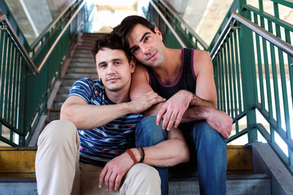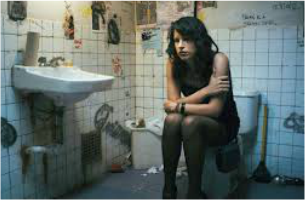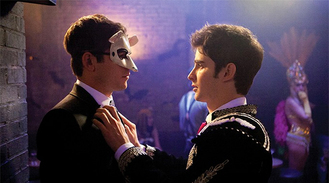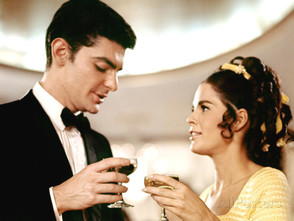In the wake of the Paris attacks, Beirut, Kenya, Sinai, Israel/Palestine, and catastrophic climate change, I start to feel overwhelmed by despair. What possible good can come of the field I have chosen to learn and dedicate my working life to? Who am I kidding? Film, theater, arts, literature...these may nourish the soul, but in a broken world, these efforts seem futile at best, indulgent at worst.
And then a story comes to light. Just an anecdote, really, and about someone I have had only passing knowledge of: Mother Teresa, of all people. The following story happened long ago to Morgan Jenness, a very talented theater colleague of my partner Brian. I share it--in her words--for all of us, especially artists, who may be filled with self-doubt or hopelessness in times like these:
And then a story comes to light. Just an anecdote, really, and about someone I have had only passing knowledge of: Mother Teresa, of all people. The following story happened long ago to Morgan Jenness, a very talented theater colleague of my partner Brian. I share it--in her words--for all of us, especially artists, who may be filled with self-doubt or hopelessness in times like these:

"When I was in my very early 20's I decided that theater was not really what I should be doing - I had seen a photo of Mother Teresa holding a very tiny baby - the two smiling/beaming at each other and it struck me like lightning that this is what I should do - go to India, find her, own only a sari and a bucket and go around picking up and caring for the sick and dying.
"So I was working temp jobs, trying to raise money to go to India and in the midst of this Mother Teresa makes a surprise trip to NYC. I call all the places she had been, call her convent in the Bronx, trying to find out how I can meet her. Someone at my job suggests I call the Indian Consulate, and when I do the man tells me that she will actually be there for a talk in about 45 minutes or so.
"I dash out of the job - saying goodbyes to all - call my friend Max to try to meet me and head up - the building is in the east 60's off Central Park as I recall...I get there and Mother Teresa has not arrived and the guard will not let me in. While I wait, two cars pull up...out of one exits a flock of nuns, and out of the other tiny Mother Teresa between two tall men. They come down the sidewalk towards me - jumping foot to foot - and she nods to the guard to let me in. My friend Max arrives and I grab her hand and we both follow Mother Teresa, the tall men, and flock of nuns up the stairs trailing behind like the duckling Ping in the Chinese folk tale.
"Max and I stand at the back of a large ballroom filled with beautiful Indian people, women in gorgeous saris, feeling out of place. Mother Teresa speaks eloquently about her work - at one point a man says, 'They say that rather than give a man a fish, one should teach him how to fish.' She says 'most of these people are not strong enough and need to be given what they need..but I will make a deal with you, I will give them a fish and when they are strong enough you can teach them how.' Booya.
"She is funny, she is tough and I am hearing angels of purpose singing in my head. At the end of the talk she is about to be taken into a smaller room and I think now or never. I fling myself at her, she takes my hand in both her hands and looks up at me (she is TINY) First I think - wow, she looks like Elizabeth Swados, and then I am caught by her eyes - which are just like burning coals. I tell her I want to come to India and pick up dying people and she asks you feel you need to do this, and I say yes and she looks at me and says no, you can not come.
"The angels stop singing. I have been rejected at first glance by Mother Teresa. She says, 'When you are so filled with love for these people that you cannot stand to be away from them for another second then you can come' and I get it - it's not about me. She asks what I do - I mumble about theater and singing...nonsense. She says, 'There are many famines. In my country there is a great famine of the body, and in your country there is a great famine of the spirit....that is what must be fed.' And she pats my hand and spins around and enters the room...I stand there and Max has to come up and take me away ....and I still carry those words with me today."
"So I was working temp jobs, trying to raise money to go to India and in the midst of this Mother Teresa makes a surprise trip to NYC. I call all the places she had been, call her convent in the Bronx, trying to find out how I can meet her. Someone at my job suggests I call the Indian Consulate, and when I do the man tells me that she will actually be there for a talk in about 45 minutes or so.
"I dash out of the job - saying goodbyes to all - call my friend Max to try to meet me and head up - the building is in the east 60's off Central Park as I recall...I get there and Mother Teresa has not arrived and the guard will not let me in. While I wait, two cars pull up...out of one exits a flock of nuns, and out of the other tiny Mother Teresa between two tall men. They come down the sidewalk towards me - jumping foot to foot - and she nods to the guard to let me in. My friend Max arrives and I grab her hand and we both follow Mother Teresa, the tall men, and flock of nuns up the stairs trailing behind like the duckling Ping in the Chinese folk tale.
"Max and I stand at the back of a large ballroom filled with beautiful Indian people, women in gorgeous saris, feeling out of place. Mother Teresa speaks eloquently about her work - at one point a man says, 'They say that rather than give a man a fish, one should teach him how to fish.' She says 'most of these people are not strong enough and need to be given what they need..but I will make a deal with you, I will give them a fish and when they are strong enough you can teach them how.' Booya.
"She is funny, she is tough and I am hearing angels of purpose singing in my head. At the end of the talk she is about to be taken into a smaller room and I think now or never. I fling myself at her, she takes my hand in both her hands and looks up at me (she is TINY) First I think - wow, she looks like Elizabeth Swados, and then I am caught by her eyes - which are just like burning coals. I tell her I want to come to India and pick up dying people and she asks you feel you need to do this, and I say yes and she looks at me and says no, you can not come.
"The angels stop singing. I have been rejected at first glance by Mother Teresa. She says, 'When you are so filled with love for these people that you cannot stand to be away from them for another second then you can come' and I get it - it's not about me. She asks what I do - I mumble about theater and singing...nonsense. She says, 'There are many famines. In my country there is a great famine of the body, and in your country there is a great famine of the spirit....that is what must be fed.' And she pats my hand and spins around and enters the room...I stand there and Max has to come up and take me away ....and I still carry those words with me today."




 RSS Feed
RSS Feed
